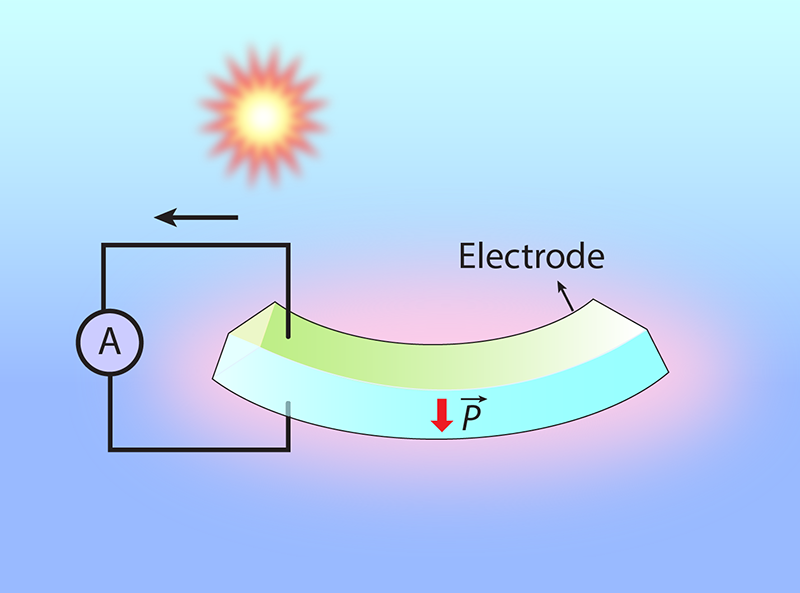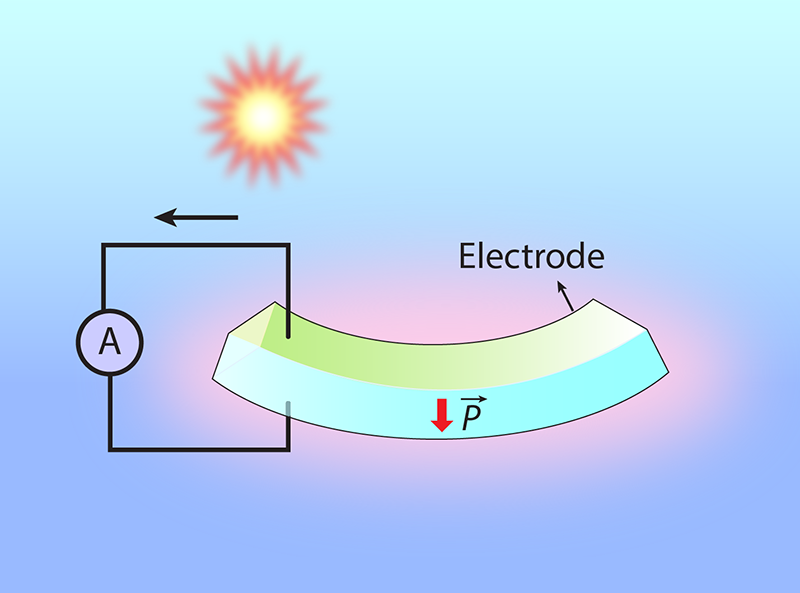Harness Strain to Harvest Solar Energy
The quest for an efficient method to convert solar energy into electricity is crucial in the pursuit of carbon neutrality and environmental sustainability. Traditional solar cells are based on junctions between semiconductors, where a current is produced by photogenerated carriers separated by an electric field at the junction. Efforts to enhance solar-cell performance have focused on refining semiconductor properties and on perfecting devices. Concurrently, researchers are exploring alternative photovoltaic mechanisms that could work in synergy with the junction-based photovoltaic effect to boost solar-cell efficiency. Within this context, the engineering of a strain gradient in the material has emerged as a promising research direction. In this phenomenon, known as the flexophotovoltaic effect, an inhomogeneous strain in the material produces a photovoltaic effect in the absence of a junction [1]. Now a team led by Gustau Catalan of the Catalan Institute of Nanoscience and Nanotechnology in Spain and Longlong Shu of Nanchang University in China has uncovered a pronounced flexophotovoltaic effect in halide perovskites—materials pivotal to the development of fourth-generation solar cells with high efficiency and low production costs [2]. Remarkably, the effect is orders of magnitude larger than in previously studied flexophotovoltaic materials, offering great promise for improving solar-cell technologies.
Photovoltaic effects require devices or materials that break inversion symmetry. The symmetry breaking creates a preferential direction for photogenerated electrons and holes to flow, generating a sizeable current before the carriers recombine. In traditional solar cells, symmetry is inherently broken at the interface between two different materials—a p–n junction between a hole-doped (p) and an electron-doped (n) material.
Certain materials, known as piezoelectrics, also display inversion-symmetry breaking in their crystallographic structures [3]. These materials display a bulk photovoltaic effect. Unlike the junction-based effect, the bulk one relies on a charge separation mechanism arising from the asymmetric distribution of photoexcited carriers in real and momentum space [4]. This behavior leads to unique characteristics, such as a photocurrent that depends on light polarization and a photovoltage that can exceed the band gap of the semiconducting material. In contrast, the photovoltage obtained in a junction-based device cannot exceed the material band gap, limiting the maximum power output of a solar cell, which scales with the product of photovoltage and photocurrent. With judicious design, both junction-based and bulk photovoltaic effects can operate in concert within a single device, boosting its performance. However, the bulk photovoltaic effect is typically plagued by low efficiency. What’s more, the semiconductors typically used in mainstream solar cells are centrosymmetric, hence do not display the bulk photovoltaic effect.
A viable approach to addressing this challenge involves altering the semiconductor structure to disrupt its symmetry. The engineering of a strain gradient, a deformation of the material structure that increases along a spatial coordinate, has proven to be an effective means to break inversion symmetry and induce an electric dipole in materials regardless of their symmetry [5]. Centrosymmetric materials subject to a strain gradient can exhibit the piezoelectric effect and transform mechanical energy into electrical energy, a phenomenon known as the flexoelectric effect [6]. Similarly, the breaking of inversion symmetry obtained by applying a strain gradient to a semiconductor can lead to the emergence of the bulk photovoltaic effect. This strain-gradient-induced photovoltaic effect is referred to as the flexophotovoltaic effect and was first demonstrated by Dong Jik Kim, Marin Alexe, both of the University of Warwick, UK, and me in the oxide perovskite SrTiO3 (STO) [1]. However, the magnitude of the effect achievable in materials—in particular, those integral to solar-cell technologies—remained until now insufficiently explored.
Catalan and collaborators investigate the flexophotovoltaic effect in single crystals of two halide perovskites called MAPbBr3 (MAPB) and MAPbI3 (MAPI), where MA stands for methylammonium, CH3NH3. Thanks to low production cost, long carrier lifetime, and excellent charge-transport properties, these hybrid perovskites, which combine both organic and inorganic compounds, have emerged as some of most attractive solar-cell materials. These and related materials led perovskite-cell efficiency to surge from about 3% in 2009 to over 25% today—a figure that rivals that of the best silicon-based solar cells [7]. Catalan, Shu, and co-workers fabricated capacitor structures by depositing electrodes on either side of these crystals. They then bent these crystals vertically to introduce an out-of-plane strain gradient and performed experiments to characterize the flexophotovoltaic efficiency (Fig 1).
Since MAPB is centrosymmetric at room temperature, the MAPB capacitor generates a negligible photocurrent when flat, but bending it activates the photovoltaic effect. Under illumination, both the measured photocurrent and the photovoltage increase linearly with the applied strain gradient. The observed response outperforms that of STO by nearly 3 orders of magnitude. Furthermore, the researchers showed that by increasing the strain gradient (through an extremely large local deformation obtained by applying pressure with the tip of an atomic force microscope), they could substantially increase the photovoltage in the crystal, achieving values more than twice larger than the material’s band gap. This achievement is groundbreaking, as it marks the first demonstration of a flexophotovoltaic-induced voltage exceeding the material band gap, underscoring the vast potential of strain gradients in enhancing photovoltaic efficiency.
MAPI capacitors, on the other hand, display a substantial bulk photovoltaic effect even in the flat state. This effect is ascribed to the presence of a macroscopic polarization within the crystal whose origin has yet to be established (it may be due to either a ferroelectric effect or chemical gradients in the material). Analogous to the behavior previously observed in ferroelectric materials, this bulk photovoltaic effect in MAPI crystal can be modulated by the application of an external bias. By bending the crystal, the flexophotovoltaic effect adds to the innate bulk photovoltaic effect, leading to an enhanced or depressed photocurrent depending on the sign of the applied strain gradient. The experiments with MAPI capacitors thus show that the flexophotovoltaic effect can coexist with other bulk photovoltaic effects—offering an option for combining multiple efficiency-enhancing phenomena.
The remarkable performance of the flexophotovoltaic effect observed by Catalan, Shu, and collaborators in halide perovskite crystals validates the ability of strain gradients to boost the efficiency of solar-energy harvesting. The relatively low elastic modulus of these halide perovskite materials suggests a higher tolerance for mechanical deformation compared to traditional organic semiconductors like silicon, meaning that significant strain gradients could be incorporated in an operational device. The next step would be the demonstration of the combination of traditional and flexophotovoltaic effects. Such a step would involve designing device configurations that integrate both built-in fields at a p–n junction and strain gradients. The results obtained for halide perovskites show that the combination of the two effects holds great potential for overcoming the tyranny of the Shockley-Queisser limit—which states that the maximum efficiency of a solar cell based on a single p–n junction cannot exceed about 30%.
References
- M.-M. Yang et al., “Flexo-photovoltaic effect,” Science 360, 904 (2018).
- Z. Wang et al., “Flexophotovoltaic effect and above-band-gap photovoltage induced by strain gradients in halide perovskites,” Phys. Rev. Lett. 132, 086902 (2024).
- W. G. Candy, Piezoelectricity (Dover Publications, Mineola, New York, 2018)[Amazon][WorldCat].
- B. I. Sturman and V. M. Fridkin, The Photovoltaic and Photorefractive Effects in Noncentrosymmetric Materials (Gordon and Breach Science Publishers, Philadelphia, 1992)[Amazon][WorldCat].
- B. Wang et al., “Flexoelectricity in solids: Progress, challenges, and perspectives,” Prog. Mater. Sci. 106, 100570 (2019).
- P. Zubko et al., “Flexoelectric effect in solids,” Annu. Rev. Mater. Res. 43, 387 (2013).
- A. K. Jena et al., “Halide perovskite photovoltaics: Background, status, and future prospects,” Chem. Rev. 119, 3036 (2019).





